
The Toshiba EMI Recordings / Original Stereo Version
12. Revolver (OP-7600, OP/AP-8443)
(Update: 11th. January 2024)

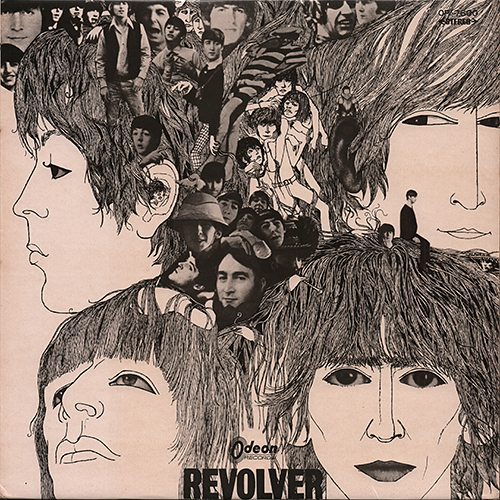 Odeon 1st. Sleeve |
|
| TITLE | REVOLVER |
||||
| CATALOG NUMBER | OP-7600 |
||||
| RELEASE DATE | Promotional
Record
(First
Press: 5th October.1966) |
||||
| TRACK LISTING | SIDE 1 | SIDE 2 | |||
| Taxman |
Good Day Sunshine |
||||
| Eleanor Rigby |
And Your Bird Can Sing |
||||
| I'm Only Sleeping |
For No One |
||||
| Love You To |
Dr. Robert |
||||
| Here, There And Everywhere |
I Want To Tell You |
||||
| Yellow Submarin |
Got To Get You
Into My Life |
||||
| She Said She Said | Tomorrow Never Knows | ||||
| COVER FRONT --> Click! | COVER BACK --> Click! | SIDE 1 --> Click! | SIDE 2 --> Click! | DISK | |
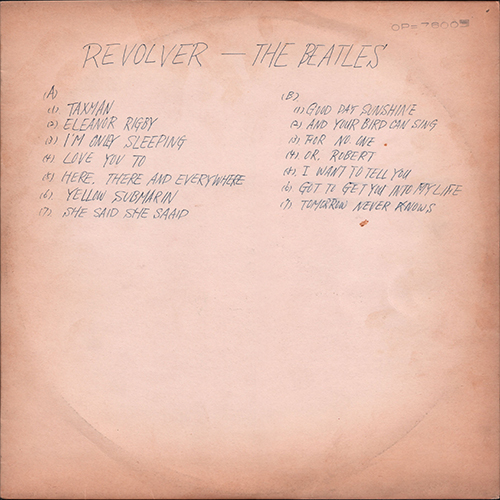 |
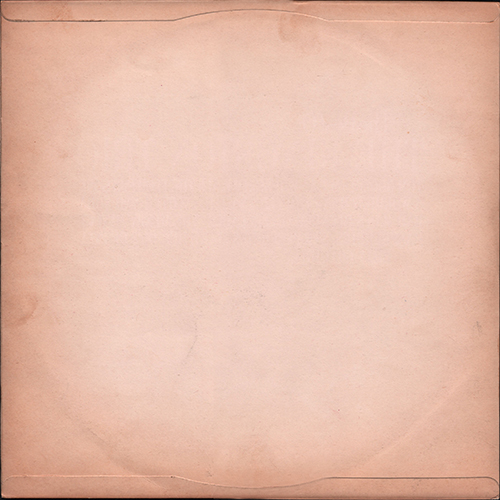 |
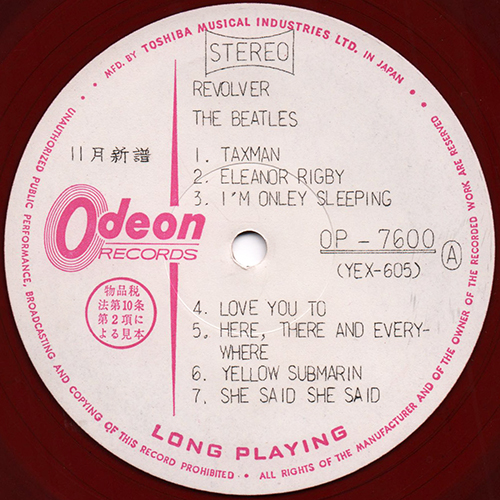 |
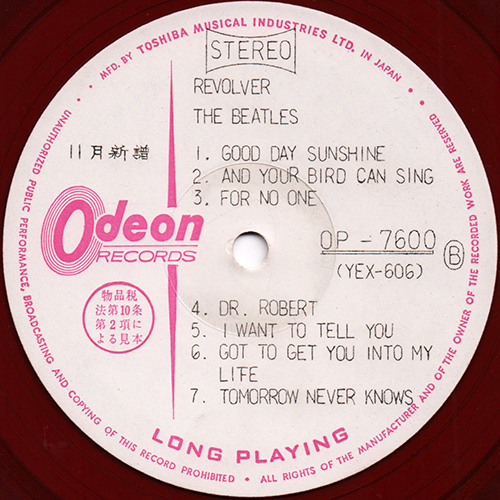 |
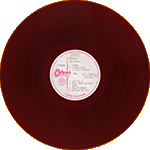 |
|
| SLEEVE SAMPLE (bifold): FRONT --> Click! | SLEEVE SAMPLE
(bifold): INSIDE --> Click! |
||||
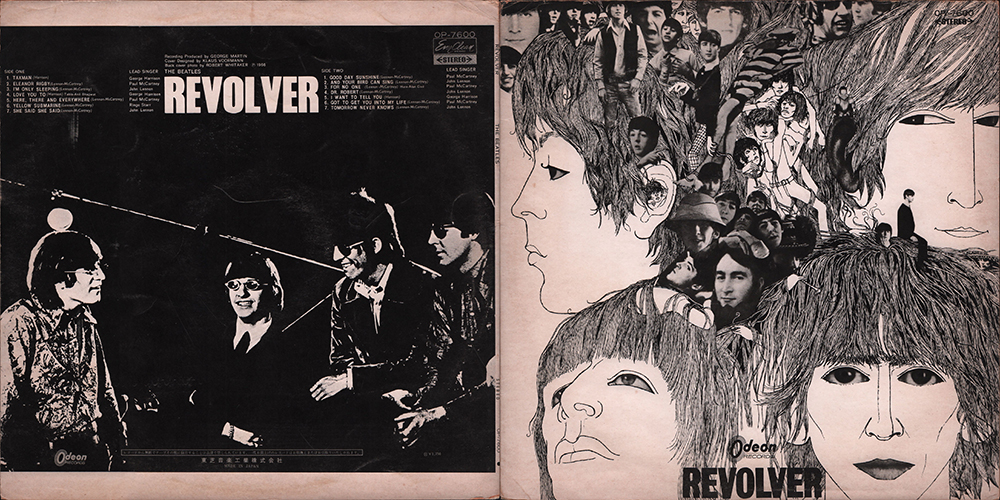 |
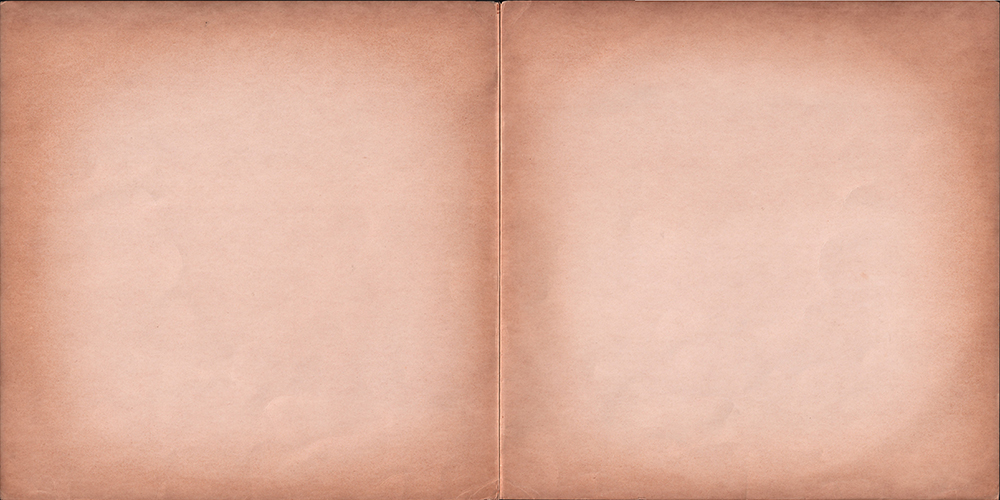 |
The sleeve is not bag-shaped, but rather
folded in half. It was probably added as a sample. |
|||
| COVER FRONT CLOSE UP | |||||
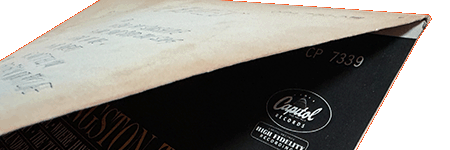 |
Promotional white sleeves are
reused by turning over existing record covers. *Catalogue number "CP-7339", The Best Of The Kingston Trio. |
||||
| COVER CLOSE UP | |||||
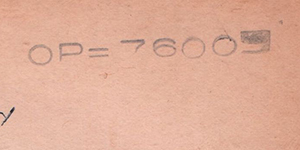 |
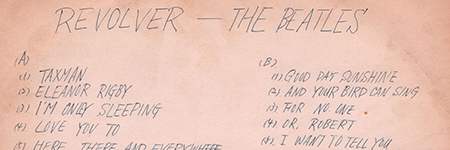 |
||||
| The catalog number
"OP-7600" was stamped at the upper right corner of the
sleeve. |
The album title
and song title were handwritten on the front sleeve. |
||||
| SLEEVE SAMPLE
(bifold): FRONT CLOSE UP |
SLEEVE SAMPLE
(bifold): INSIDE CLOSE UP |
||||
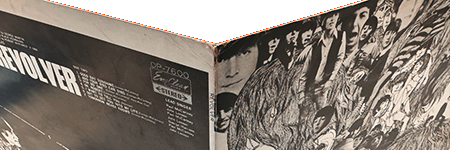 |
 |
||||
| SAMPLE SLEEVE: FRONT CLOSE UP | SAMPLE SLEEVE: FRONT CLOSE UP | ||||
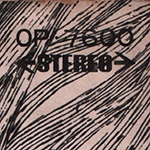 |
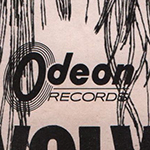 |
Caqtalog number and Odeon logomark were
printed on both sides of the sleeve. |
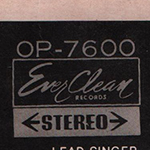 |
Ever Clean" logo and "STEREO"mark were
printed at the upper right corner of the back cover. |
|
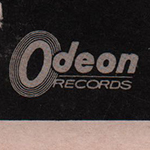 |
 |
 |
|||
| Odeon logo and the company name
"Toshiba Musical Industries Ltd." were printed at the bottom
of the back cover. |
"H ¥1,750" was printed at the bottom of the
back cover. |
||||
| LABEL CLOSE UP |
|||||
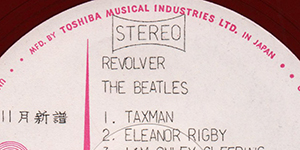 |
Odeon white label (promotional use only). The print in black has unusual "hand lettered" look to it quite unlike the regular commercial version. The words "MFD. BY TOSHIBA MUSICAL INDUSTRIES LTD. IN JAPAN" was printed at the perimeter. |
||||
| LABEL CLOSE UP | |||||
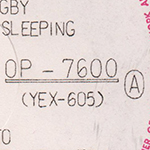 |
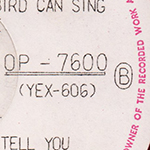 |
Catalog number and matrix number were printed at the right side of the center hole. | 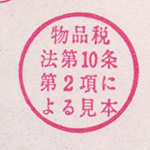 |
Here is a close-up of the circled text: "Sample under Article 10, Clause 2 of the Commodity Tax Law". | |
| LABEL CLOSE UP | |||||
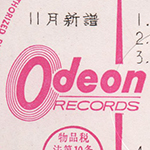 |
The release
date "November, New album" is in black and appears above the
Odeon logo. |
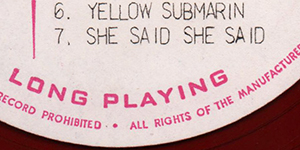 |
The words "LONG PLAYING" was printed at the bottom of the label. | ||
| LABEL CLOSE UP | |||||
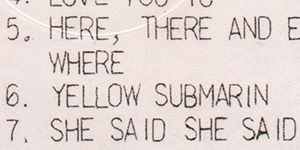 |
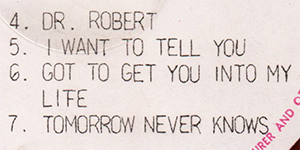 |
The song title of the 6th.
song on side-1, this label was misprinted "Yellow Submarin"
instead of "Yellow Submarine". Track as "Dr. Robert". |
|||
|
OTHER ITEM
|
|||||
| - | |||||
| RECORD LABEL | Odeon White Label (for promotional use
only) |
||||
| MIX | STEREO |
||||
| MATRIX No. | SIDE 1 | YEX-605 1 |
|||
| SIDE 2 | YEX-606 1 | ||||
| PRESS MARK | - |
||||
| VINYL COLOR | RED |
||||
| RECORD COMPANY'S NAME | SLEEVE | Toshiba Musical Industries Ltd. |
|||
| LABEL | MFD. BY
TOSHIBA MUSICAL INDUSTRIES LTD. IN JAPAN |
||||
| SYMBOL/PRICE | H ¥1750 |
||||
| LYRIC SHEET STYLE | - |
||||
| COVER FORM | Plain white sleeve with album "Revolver" sample sleeve (bifold) |
||||
| INNER SLEEVE |
- |
||||
| OBI |
- |
||||
| COVER DESIGN/ PHOTO/ NOTES | with Sample Sleeve
(bifold): Front cover features artwork by Klaus
Voormann, Rear cover photograph is by Robert Whittaker |
||||
|
COMMENTS
|
Odeon white label
(promotional use only). The words "MFD. BY TOSHIBA MUSICAL INDUSTRIES LTD. IN JAPAN" was printed at the perimeter on the label. The words "LONG PLAYING" was printed at the bottom of the label. The song title of the 6th. song on side-1, this label was misprinted "Yellow Submarin" instead of "Yellow Submarine". Track as "Dr. Robert" (NOT Doctor Robert) Odeon promo LPs feature the perimeter print, Odeon logo, and circled text in red and all other printing in "hand lettered" black. Note the release date above the Odeon logo. The label design is similar to that used for the regular commercial Odeon LPs. These are most commonly found on red vinyl. Promotional white sleeves are reused by turning over existing record covers. *Catalogue number "CP-7339", The Best Of The Kingston Trio. The album sleeve is not bag-shaped, but rather folded in half. It was probably added as a sample. In Japan, promotional records have traditionally been provided at no charge to radio stations, record shops, and the mass media to increase the sales of a record or in some cases to promote a tour. There are two types of promotional releases. Type-1: This type is called the white label promo for which a unique label has been made. The label design of Odeon white label singles is very similar to that of regular commercial Odeon singles. The promo version, however, features the perimeter print, Odeon logo, and circled text in red and all other printing in black. The print in black has an unusual "hand lettered" look to it quite unlike the regular commercial version. The release date is in black and appears above and to the left of the title. Most usually, the regular cover is used with appropriate alterations to prohibit commercial sale. Type-2: The second type of promo record is less elaborate and is called a sticker promo. It is simply a regular commercial release that has a promo sticker affixed to the cover. This type of promo is occasionally found on post-1975 releases. |
||||
| TITLE | REVOLVER | ||||
| CATALOG NUMBER | OP-7600 |
||||
| RELEASE DATE | 5th October.1966 / First Press |
||||
| TRACK LISTING | SIDE 1 | SIDE 2 | |||
| Taxman |
Good Day Sunshine |
||||
| Eleanor Rigby |
And Your Bird Can Sing |
||||
| I'm Only Sleeping |
For No One |
||||
| Love You To |
Dr. Robert |
||||
| Here, There And Everywhere |
I Want To Tell You |
||||
| Yellow Submarine |
Got To Get You Into My Life | ||||
| She Said She Said |
Tomorrow Never Knows | ||||
| FRONT --> Click! | BACK --> Click! | SIDE 1 --> Click! | SIDE 2 --> Click! | DISK | |
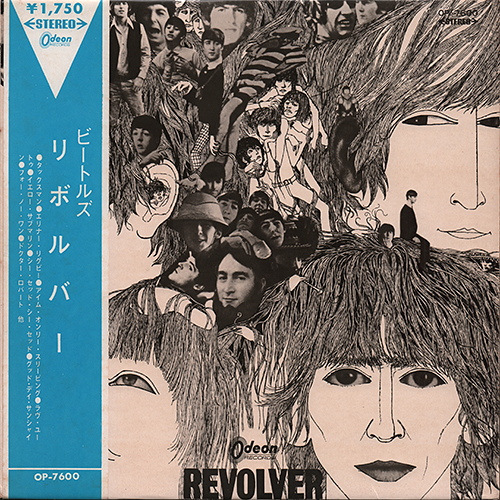 |
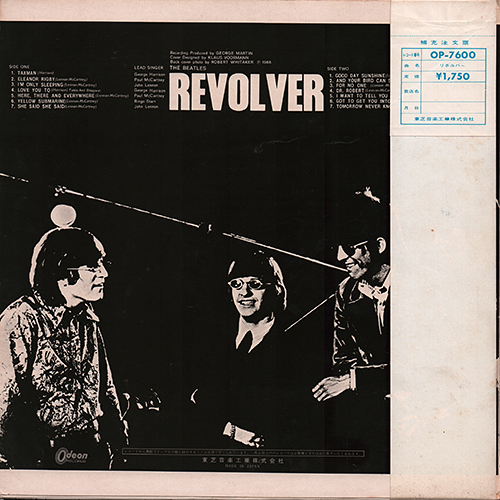 |
 |
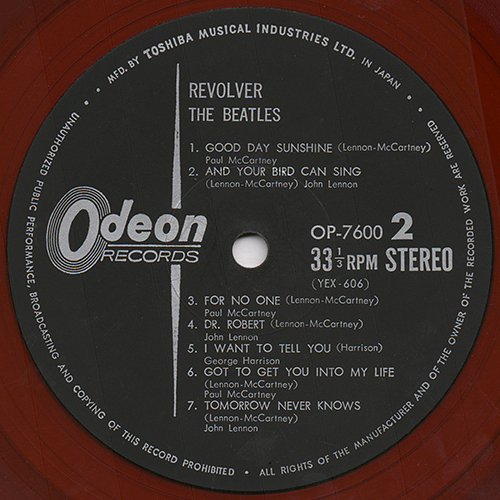 |
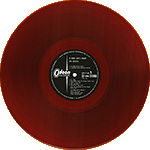 |
|
| INNER SLEEVE |
INNER SLEEVE CLOSE UP |
||||
| FRONT --> Click! | BACK --> Click! | ||||
 |
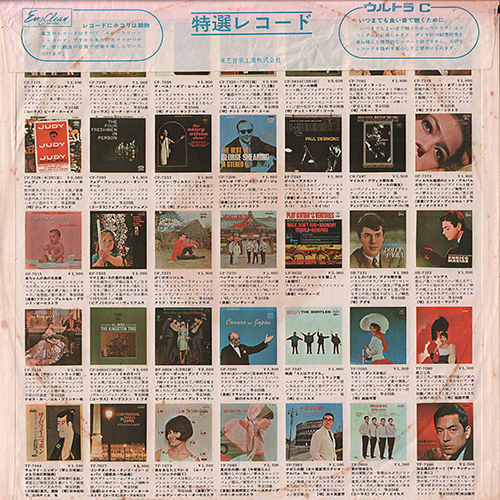 |
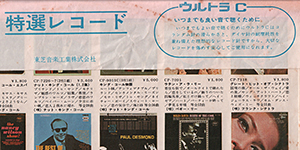 |
The original colour
"advert" inner bag has a fold-over flap at the top of the
bag to prevent the record from falling out. |
||
| LYRIC SHEET (Bifold Type) | |||||
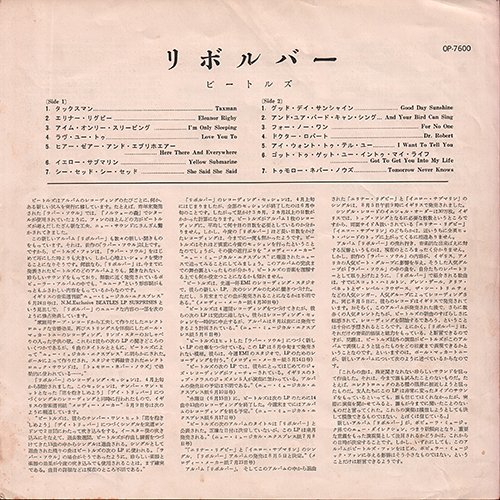 |
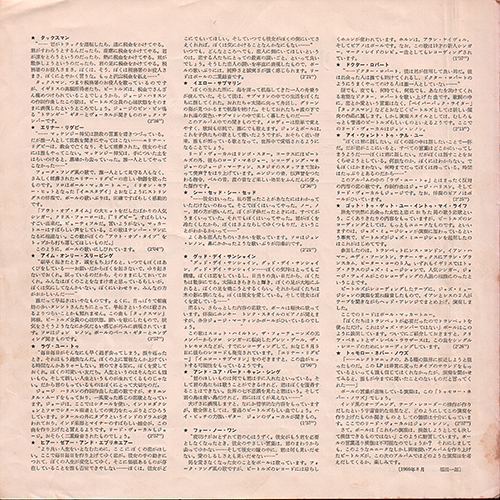 |
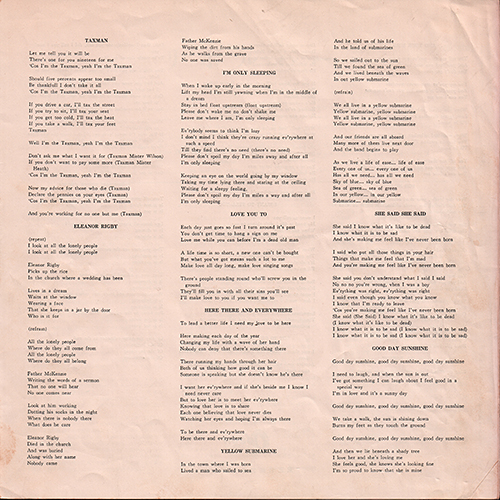 |
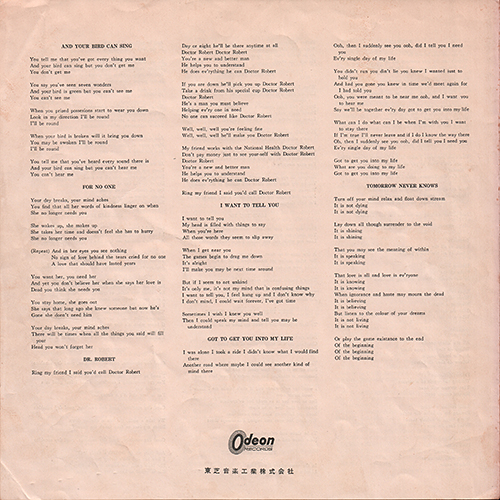 |
The lyric sheet is bifold
type. |
|
| INNER SLEEVE CLOSE UP |
LYRIC SHEET CLOSE UP | ||||
 |
 |
 |
Catalog
number,
Odeon logo, and the company name were printed on the lyric
sheet. Liner notes: August 1966, Ichiro Fukuda. |
||
| "LIGHT BLUE" OBI CLOSE UP | |||||
| FRONT --> Click! | BACK --> Click! | ||||
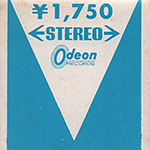 |
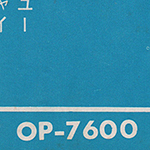 |
1st.. pressing had a light blue / white so called "Sankaku"(triangle) or "V-shape" OBI and priced ¥1750 on rear sleeve and obi strip. | 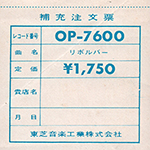 |
The obi remains intact
with the order form on the back uncut. |
|
| FRONT AND BACK COVER CLOSE UP | |||||
| FRONT COVER | BACK COVER | Caqtalog
number
and Odeon logomark were printed on both sides of the sleeve. EverClean" logo and "STEREO"mark were printed at the upper right corner of the back cover. |
|||
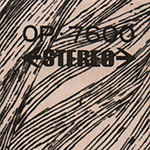 |
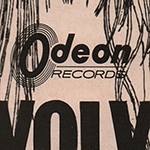 |
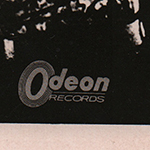 |
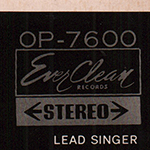 |
||
| BACK COVER CLOSE UP | |||||
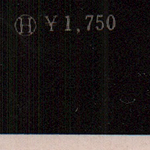 |
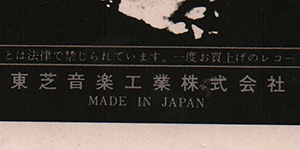 |
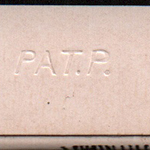 |
"H ¥1,750" and the company
name "Toshiba Musical Industries Ltd." were printed at the
bottom of the back cover. The words "PAT.P. (italic type)" was embossed at the lower right. |
||
| LABEL CLOSE UP | |||||
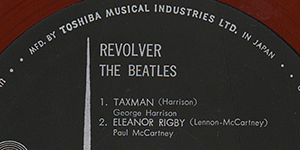 |
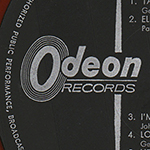 |
Toshiba
pressed a lot of their records on red, "Everclean" vinyl
from 1958 through 1974 (maybe). The Everclean vinyl
was designed to be less prone to collecting static
electricity and dust than the more common black vinyl. The
words "MFD. BY TOSHIBA MUSICAL INDUSTRIES LTD. IN JAPAN" was
printed at the perimeter. |
|||
| LABEL CLOSE UP | |||||
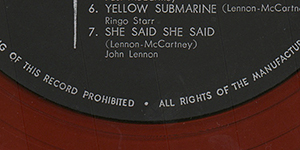 |
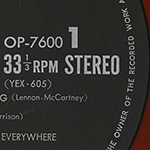 |
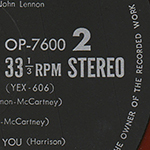 |
The words "LONG PLAYING" was removed at the bottom of
the label. Catalog number and matrix number were printed at the right side of the center hole. |
||
|
OTHER ITEM
|
|||||
| - | |||||
| RECORD LABEL | Odeon Label Type-2 (without the words "LONG
PLAYING") |
||||
| MIX | STEREO | ||||
| MATRIX No. | SIDE 1 | YEX-605-2
19 |
|||
| SIDE 2 | YEX-606-2 9 | ||||
| PRESS MARK | J6 |
||||
| VINYL COLOR | RED |
||||
| RECORD COMPANY'S NAME | SLEEVE | Toshiba
Ongaku kogyo Kabusikigaisha |
|||
| LABEL | MFD. BY
TOSHIBA MUSICAL INDUSTRIES LTD. IN JAPAN |
||||
| SYMBOL/PRICE | H -
¥1,750 |
||||
| LYRIC SHEET STYLE | Bifold Type |
||||
| COVER FORM | Single type. Hard cover. Twin-flipback cover (straight type) |
||||
| INNER SLEEVE |
The
original colour "advert" inner bag Type-4 |
||||
| OBI |
Light blue / white so called "Sankaku" (triangle) or "V-shape" OBI | ||||
| COVER DESIGN/ PHOTO/ NOTES | Notes: Ichiro Fukuda |
||||
|
COMMENTS
|
Toshiba released the
first Japanese record featuring the Beatles. When this record was released, Toshiba's official name was "Toshiba Musical Industries Ltd." and they used the Odeon label for this and subsequent Beatles releases. Black Odeon label with silver print: The words "LONG PLAYING" was removed at the bottom of the label. Red vinyl: Besides good sound and quality printing, Japanese records also offered some other things of interest to the collector. One of the primary manufacturing companies in Japan, Toshiba, pressed a lot of their records on red, “Everclean” vinyl from 1958 through 1974 (maybe). While not pressed as collectors’ items, these red vinyl pressings are more sought out by collectors than their black vinyl counterparts. The Everclean vinyl was designed to be less prone to collecting static electricity and dust than the more common black vinyl. The obi: A. K. A."V-shape" Obi First pressing had a light blue/white so called "Sankaku"(triangle) or "V-shape" OBI and priced ¥1750 on rear sleeve and obi strip. It also features an Odeon logo, catalogue number and price information. Only issued briefly in 1966 August till November. Soon, price changed ¥2,000 with different obi (green arrow obi) and different catalog number (OP-8443). While most Japanese records feature local music, a lot of music fans there like foreign music, as well. The language barrier in Japan presented a problem – should foreign album covers be changed for Japanese albums? The solution was the obi, which means “belt” or “sash”. The obi is a strip of paper, usually about two inches wide, that wraps vertically around the album cover, containing information about the artist and album in Japanese. As these strips of paper were fragile and easily torn, they are often missing, especially since consumers in the 1950s and 1960s attached little significance to them. Finding Japanese records made prior to 1970 that still have the obi intact can be quite difficult, and for some albums, nearly impossible. The inclusion of the obi can dramatically affect the price of some Japanese records, sometimes increasing the price by a factor of ten. |
||||
| TITLE | REVOLVER | ||||
| CATALOG NUMBER | OP-8443 |
||||
| RELEASE DATE | February 1969 ? / Second Press |
||||
| TRACK LISTING | SIDE 1 | SIDE 2 | |||
| Taxman |
Good Day Sunshine |
||||
| Eleanor Rigby |
And Your Bird Can Sing |
||||
| I'm Only Sleeping |
For No One |
||||
| Love You To |
Dr. Robert |
||||
| Here, There And Everywhere |
I Want To Tell You |
||||
| Yellow Submarine |
Got To Get You Into My Life | ||||
| She Said She Said |
Tomorrow Never Knows | ||||
| FRONT --> Click! | BACK --> Click! | SIDE 1 --> Click! | SIDE 2 --> Click! | DISK | |
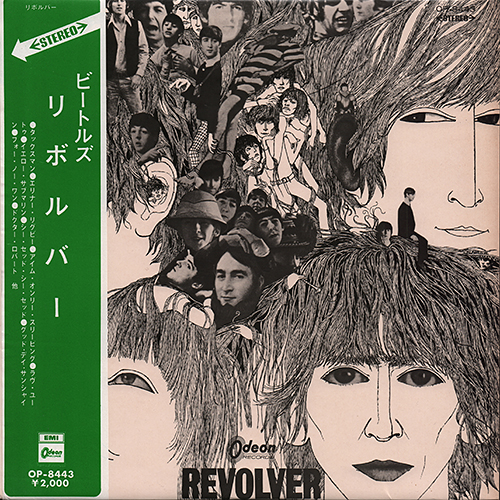 |
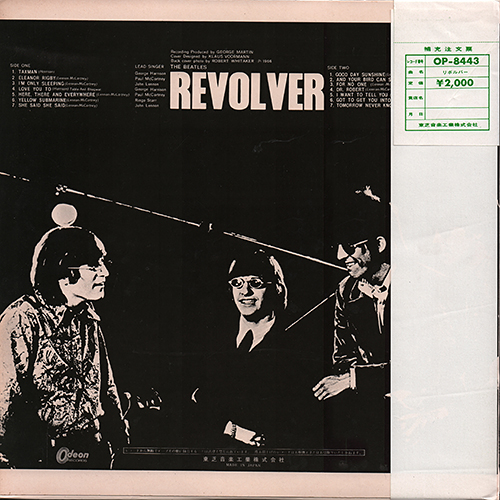 |
 |
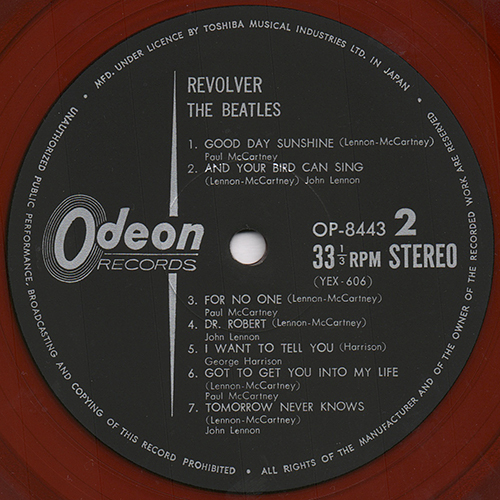 |
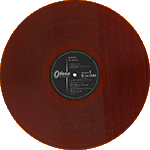 |
|
| INNER SLEEVE |
INNER SLEEVE CLOSE UP |
||||
| FRONT --> Click! | BACK --> Click! | ||||
 |
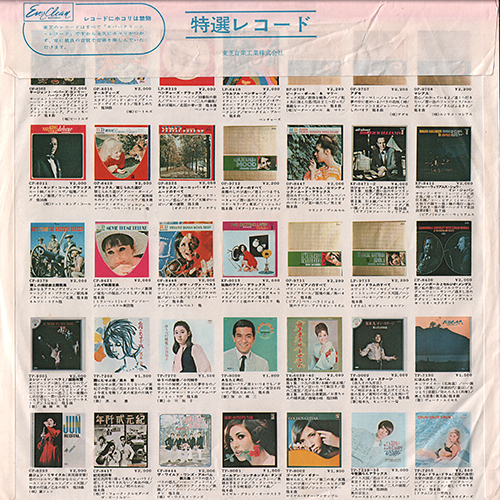 |
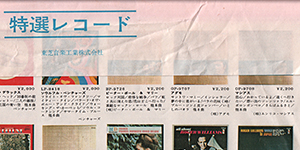 |
The original colour
"advert" inner bag has a fold-over flap at the top of the
bag to prevent the record from falling out. |
||
| LYRIC SHEET (Bifold Type) | |||||
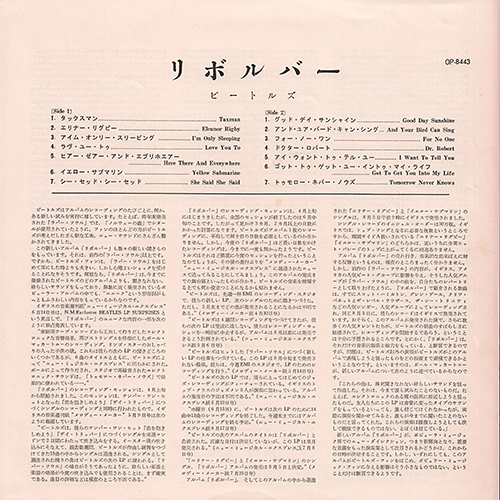 |
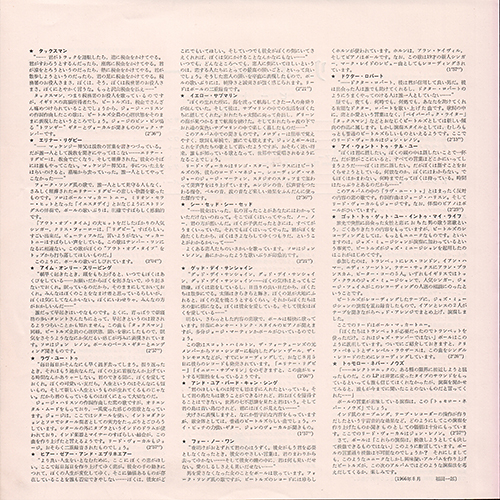 |
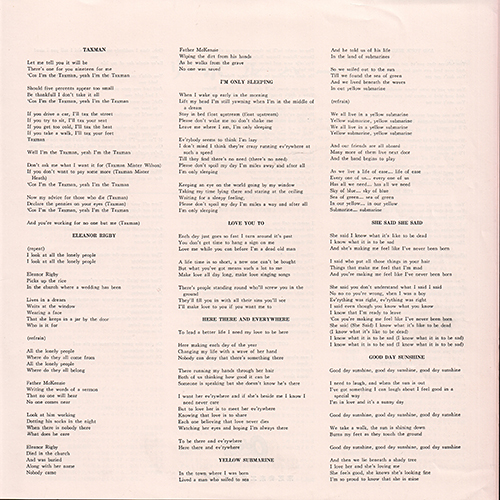 |
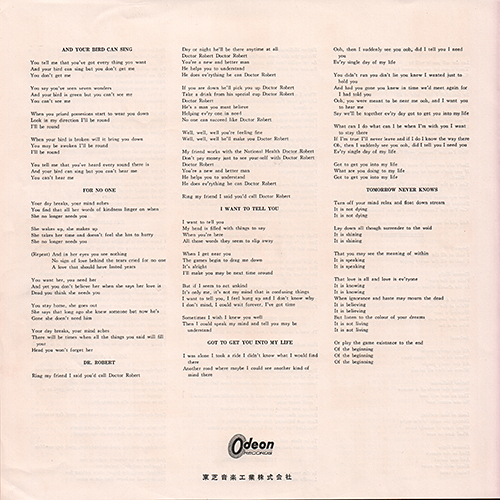 |
The lyric sheet is bifold
type. |
|
| INNER SLEEVE CLOSE UP |
LYRIC SHEET CLOSE UP | ||||
 |
 |
 |
Catalog
number,
Odeon logo, and the company name were printed on the lyric
sheet. Liner notes: August 1966, Ichiro Fukuda. |
||
| Odeon Green Arrow OBI CLOSE UP | |||||
| FRONT --> Click! | BACK --> Click! | ||||
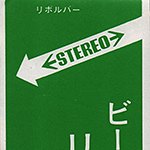 |
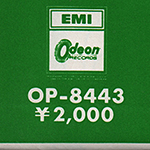 |
2nd. pressing had a green "arrow" OBI and
priced ¥2,000 on obi strip. The word "STEREO", EMI/Odeon logo mark and
catalog number "OP-8443" were printed on the front. |
 |
The obi remains intact
with the order form on the back uncut. |
|
| FRONT AND BACK COVER CLOSE UP | |||||
| FRONT COVER | BACK COVER | Caqtalog
number
and Odeon logomark were printed on both sides of the sleeve. EverClean" logo and "STEREO"mark were printed at the upper right corner of the back cover. |
|||
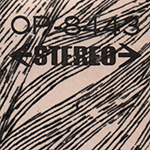 |
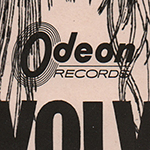 |
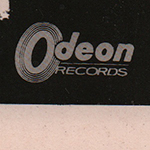 |
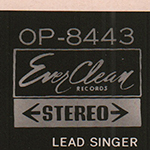 |
||
| BACK COVER CLOSE UP | |||||
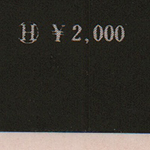 |
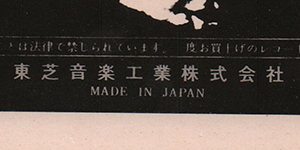 |
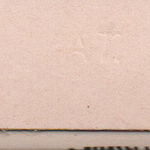 |
"H ¥2,000" and the company
name "Toshiba Musical Industries Ltd." were printed at the
bottom of the back cover. The words "PAT. (italic type)" was embossed at the lower right. |
||
| LABEL CLOSE UP | |||||
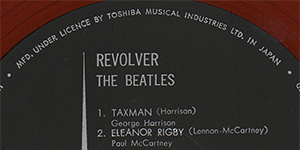 |
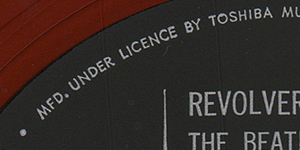 |
The words "MFD. UNDER LICENCE BY TOSHIBA MUSICAL INDUSTRIES LTD. IN JAPAN" was printed at the perimeter. | |||
 |
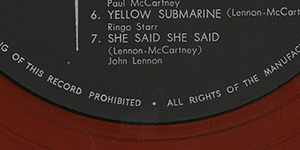 |
Toshiba
pressed a lot of their records on red, "Everclean" vinyl
from 1958 through 1974 (maybe). The Everclean vinyl
was designed to be less prone to collecting static
electricity and dust than the more common black vinyl. The words "LONG PLAYING" was removed at the bottom of the label. |
|||
| LABEL CLOSE UP | |||||
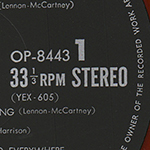 |
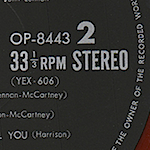 |
Catalog number "OP-8443" and matrix number were printed at the right side of the center hole. |
|||
|
OTHER ITEM
|
|||||
| - | |||||
| RECORD LABEL | Odeon Label Type-3 ("MFD. UNDER LICENCE BY"
perimeter and without
the words "LONG PLAYING") |
||||
| MIX | STEREO | ||||
| MATRIX No. | SIDE 1 | YEX-605-3 4 | |||
| SIDE 2 | YEX-606-3 17 | ||||
| PRESS MARK | 8H
-> 9B |
||||
| VINYL COLOR | RED |
||||
| RECORD COMPANY'S NAME | SLEEVE | Toshiba
Ongaku kogyo Kabusikigaisha |
|||
| LABEL | MFD. UNDER LICENCE BY TOSHIBA
MUSICAL INDUSTRIES LTD. IN JAPAN |
||||
| SYMBOL/PRICE | H -
¥2,000 |
||||
| LYRIC SHEET STYLE | Bifold Type |
||||
| COVER FORM | Single type. Hard cover. Twin-flipback cover (straight type) |
||||
| INNER SLEEVE |
The
original colour "advert" inner bag Type-7 |
||||
| OBI |
Green / white so called "Odeon Arrow" OBI |
||||
| COVER DESIGN/ PHOTO/ NOTES | Notes: Ichiro Fukuda |
||||
|
COMMENTS
|
Toshiba released the
first Japanese record featuring the Beatles. When this record was released, Toshiba's official name was "Toshiba Musical Industries Ltd." and they used the Odeon label for this and subsequent Beatles releases. Black Odeon label with silver print: The words "LONG PLAYING" was removed at the bottom of the label. Odeon label was changed from type-2 to type-3. The words "MFD. UNDER LICENCE BY TOSHIBA MUSICAL INDUSTRIES LTD. IN JAPAN" was printed at the perimeter. Taking advantage of the rise in LP prices in 1967, the price of a stereo LP rose to 2,000 yen. Already released Beatles LPs have been reissued with the record number changed to OP-8,000, and the obi changed to an arrow obi. The alphabet symbol and price display on the back of the cover have also been changed to "H ¥2,000". Red vinyl: Besides good sound and quality printing, Japanese records also offered some other things of interest to the collector. One of the primary manufacturing companies in Japan, Toshiba, pressed a lot of their records on red, “Everclean” vinyl from 1958 through 1974 (maybe). While not pressed as collectors’ items, these red vinyl pressings are more sought out by collectors than their black vinyl counterparts. The Everclean vinyl was designed to be less prone to collecting static electricity and dust than the more common black vinyl. The obi: A. K. A."Arrow" Obi 2nd. pressing had a green / white so called "Arrow" OBI and priced ¥2000 on rear sleeve and obi strip. On June 1967, starting with "Oldies (OP-8016)", numbering for new Odeon LPs changed to the 8000 range numbers. So Obis were renew, A.K.A. Odeon "Arrow Obi" in green and with the same design as the Apple Obis. While most Japanese records feature local music, a lot of music fans there like foreign music, as well. The language barrier in Japan presented a problem – should foreign album covers be changed for Japanese albums? The solution was the obi, which means “belt” or “sash”. The obi is a strip of paper, usually about two inches wide, that wraps vertically around the album cover, containing information about the artist and album in Japanese. As these strips of paper were fragile and easily torn, they are often missing, especially since consumers in the 1950s and 1960s attached little significance to them. Finding Japanese records made prior to 1970 that still have the obi intact can be quite difficult, and for some albums, nearly impossible. The inclusion of the obi can dramatically affect the price of some Japanese records, sometimes increasing the price by a factor of ten. |
||||
| TITLE | REVOLVER | ||||
| CATALOG NUMBER | AP-8443 |
||||
| RELEASE DATE | September 1969 ? / Third Press |
||||
| TRACK LISTING | SIDE 1 | SIDE 2 | |||
| Taxman |
Good Day Sunshine |
||||
| Eleanor Rigby |
And Your Bird Can Sing |
||||
| I'm Only Sleeping |
For No One |
||||
| Love You To |
Dr. Robert |
||||
| Here, There And Everywhere |
I Want To Tell You |
||||
| Yellow Submarine |
Got To Get You Into My Life | ||||
| She Said She Said |
Tomorrow Never Knows | ||||
| FRONT --> Click! | BACK --> Click! | SIDE 1 --> Click! | SIDE 2 --> Click! | DISK | |
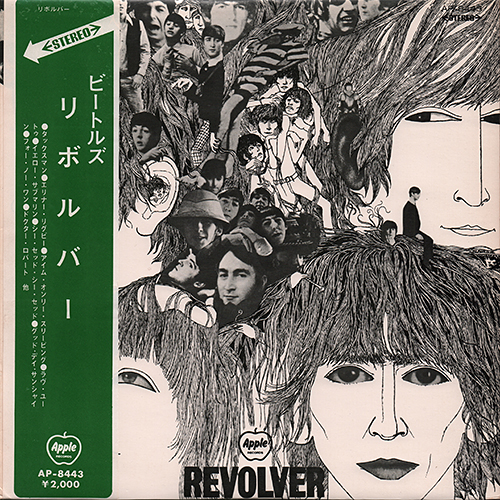 |
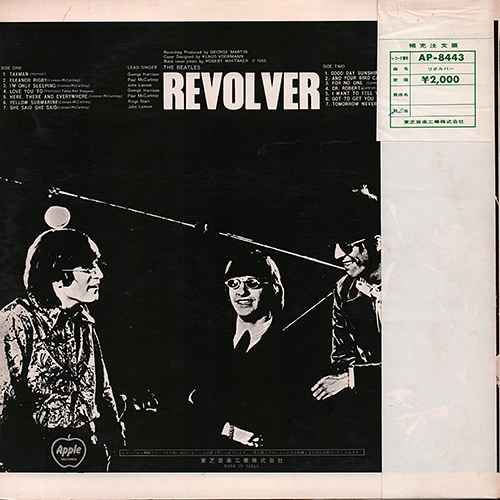 |
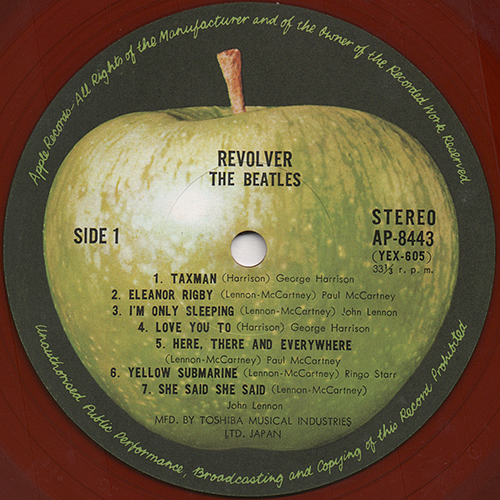 |
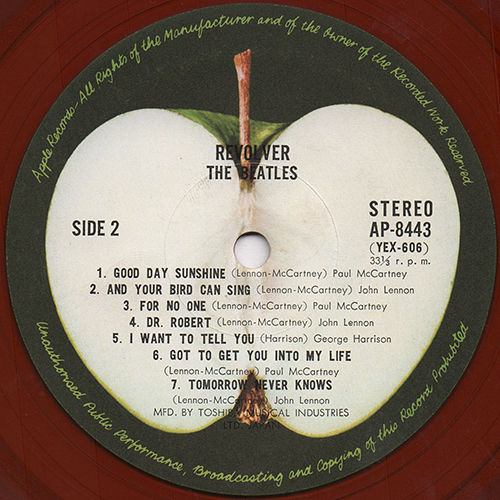 |
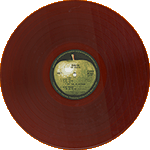 |
|
| INNER SLEEVE |
LYRIC SHEET (Bifold Type) | ||||
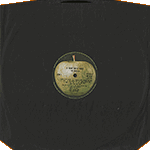 |
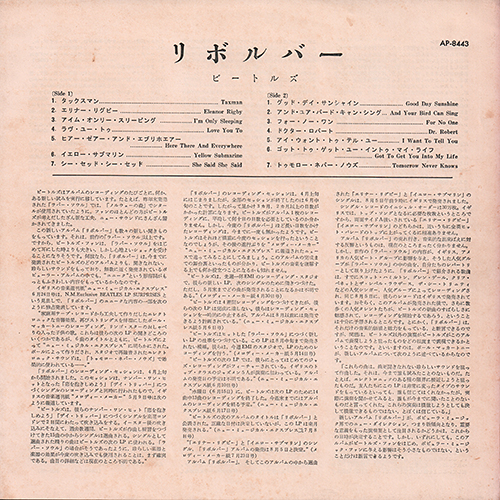 |
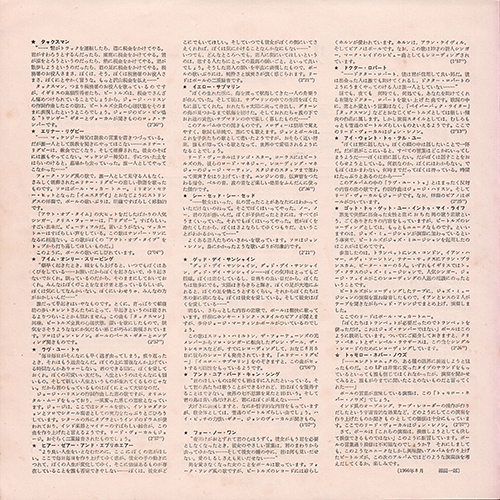 |
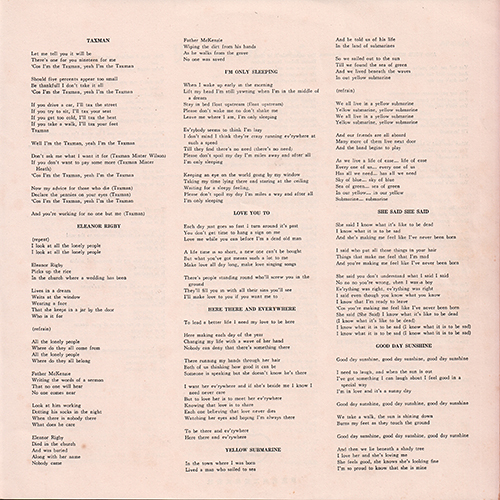 |
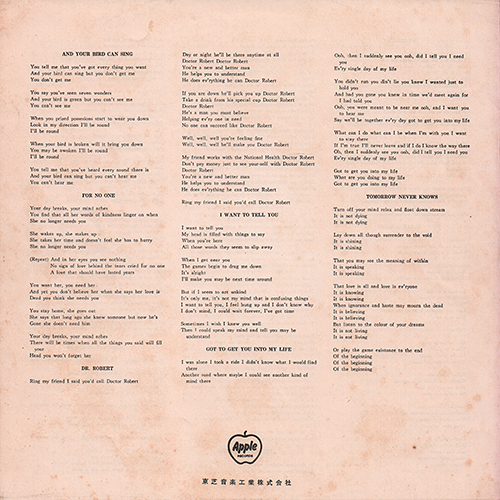 |
|
| LYRIC SHEET CLOSE UP | |||||
 |
 |
 |
Catalog
number,
Apple logo, and the company name were printed on the lyric
sheet. Liner notes: August 1966, Ichiro Fukuda. |
||
| Apple Green Arrow OBI CLOSE UP | |||||
| FRONT | BACK --> Click! | ||||
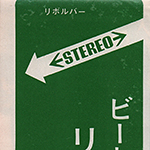 |
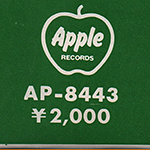 |
2nd. pressing had a green "arrow" OBI and
priced ¥2,000 on obi strip. The word "STEREO", Apple logo
mark and catalog
number "AP-8443" were printed on the front. |
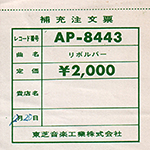 |
The obi remains intact
with the order form on the back uncut. |
|
| FRONT AND BACK COVER CLOSE UP | |||||
| FRONT COVER | BACK COVER | Caqtalog
number
and Apple logomark were printed on both sides of the sleeve. "Ever Clean" logo mark was removed on the back cover. |
|||
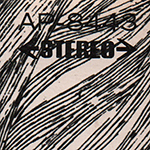 |
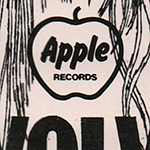 |
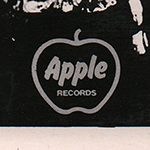 |
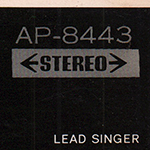 |
||
| BACK COVER CLOSE UP | |||||
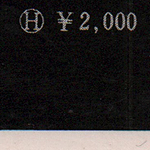 |
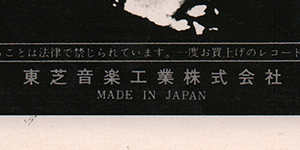 |
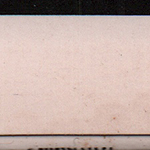 |
"H ¥2,000" and the company
name "Toshiba Musical Industries Ltd." were printed at the
bottom of the back cover. The words "PAT." was removed at the lower right of the cover. |
||
| LABEL CLOSE UP | |||||
 |
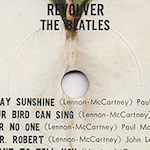
|
In 1969,
Toshiba had to reissue on the Apple label all the records
previously issued on the Odeon label. The phrase "Apple Records - All Rights of the Manufacturer and of the Owner of the Recorded work Reserved." was printed at the perimeter. |
|||
| LABEL CLOSE UP | |||||
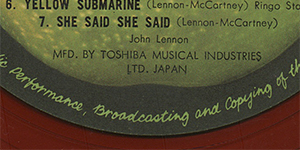 |
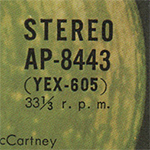 |
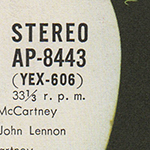
|
The words "MFD. BY TOSHIBA
MUSICAL INDUSTRIES LTD. JAPAN" was printed at the bottom of
the label. Catalog number "AP-8443" and matrix number were printed at the right side of the center hole. |
||
|
OTHER ITEM
|
|||||
| - | |||||
| RECORD LABEL | Dark Green Apple label Type-1 |
||||
| MIX | STEREO | ||||
| MATRIX No. | SIDE 1 | YEX-605 42 | |||
| SIDE 2 | YEX-606 32 | ||||
| PRESS MARK | 8J
-> 8M -> 9G -> 9J |
||||
| VINYL COLOR | RED |
||||
| RECORD COMPANY'S NAME | SLEEVE | Toshiba
Ongaku kogyo Kabusikigaisha |
|||
| LABEL | MFD. BY
TOSHIBA MUSICAL INDUSTRIES LTD. JAPAN |
||||
| SYMBOL/PRICE | H - ¥2,000 |
||||
| LYRIC SHEET STYLE | Bifold Type |
||||
| COVER FORM | Single type. Hard cover. Twin-flipback cover (straight type) |
||||
| INNER SLEEVE |
Apple
custom black sleeve |
||||
| OBI |
Green / white so called "Apple Arrow" OBI |
||||
| COVER DESIGN/ PHOTO/ NOTES | Notes: Ichiro Fukuda |
||||
|
COMMENTS
|
Dark green Apple label
Type-1with black print. In late (September?)1969, Toshiba had to reissue on the Apple label all the records previously issued on the Odeon label. And in the Apple label, there are two subtypes, TOSHIBA MUSIC and TOSHIBA EMI. Further more, the early copies of the APPLE-TOSHIBA MUSIC type have dark Apple on its label, though the late copies have light one. Red vinyl: Besides good sound and quality printing, Japanese records also offered some other things of interest to the collector. One of the primary manufacturing companies in Japan, Toshiba, pressed a lot of their records on red, “Everclean” vinyl from 1958 through 1974 (maybe). While not pressed as collectors’ items, these red vinyl pressings are more sought out by collectors than their black vinyl counterparts. The Everclean vinyl was designed to be less prone to collecting static electricity and dust than the more common black vinyl. This LP was manufactured two ways: both Black and Red vinyl. The obi: A. K. A."Arrow" Obi 3rd. pressing had a green / white so called "Arrow" OBI and priced ¥2000 on rear sleeve and obi strip. On June 1967, starting with "Oldies (OP-8016)", numbering for new Odeon LPs changed to the 8000 range numbers. So Obis were renew, A.K.A. Odeon "Arrow Obi" in green and with the same design as the Apple Obis. While most Japanese records feature local music, a lot of music fans there like foreign music, as well. The language barrier in Japan presented a problem – should foreign album covers be changed for Japanese albums? The solution was the obi, which means “belt” or “sash”. The obi is a strip of paper, usually about two inches wide, that wraps vertically around the album cover, containing information about the artist and album in Japanese. As these strips of paper were fragile and easily torn, they are often missing, especially since consumers in the 1950s and 1960s attached little significance to them. Finding Japanese records made prior to 1970 that still have the obi intact can be quite difficult, and for some albums, nearly impossible. The inclusion of the obi can dramatically affect the price of some Japanese records, sometimes increasing the price by a factor of ten. |
||||
| TITLE | REVOLVER | ||||
| CATALOG NUMBER | AP-8443 |
||||
| RELEASE DATE | October 1972 ? / 4th. Press |
||||
| TRACK LISTING | SIDE 1 | SIDE 2 | |||
| Taxman |
Good Day Sunshine |
||||
| Eleanor Rigby |
And Your Bird Can Sing |
||||
| I'm Only Sleeping |
For No One |
||||
| Love You To |
Dr. Robert |
||||
| Here, There And Everywhere |
I Want To Tell You |
||||
| Yellow Submarine |
Got To Get You Into My Life | ||||
| She Said She Said |
Tomorrow Never Knows | ||||
| FRONT --> Click! | BACK --> Click! | SIDE 1 --> Click! | SIDE 2 --> Click! | DISK | |
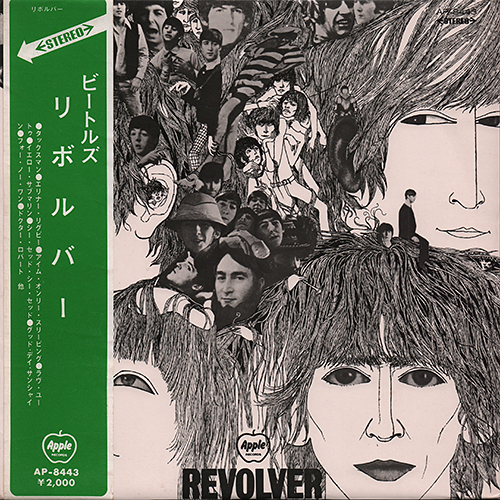 |
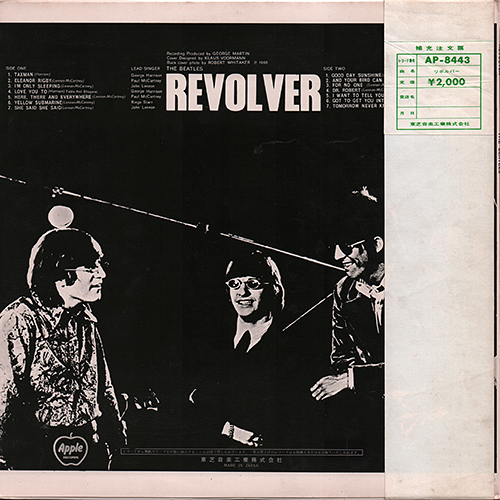 |
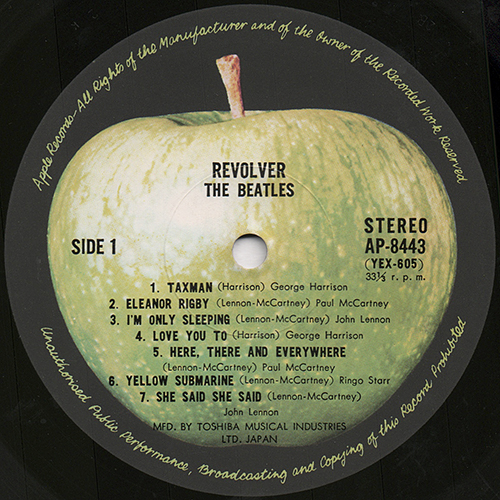 |
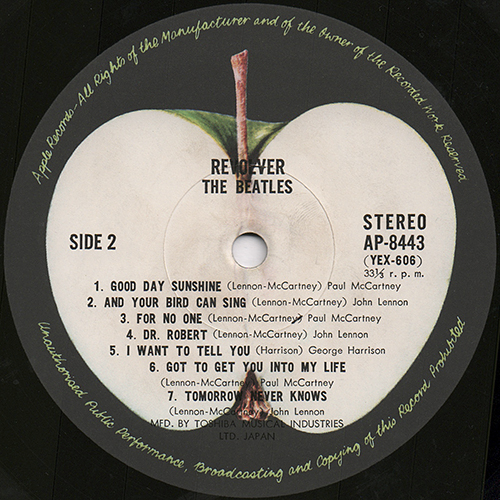 |
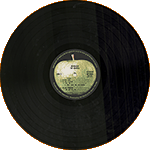 |
|
| INNER SLEEVE |
LYRIC SHEET (Bifold Type) | ||||
 |
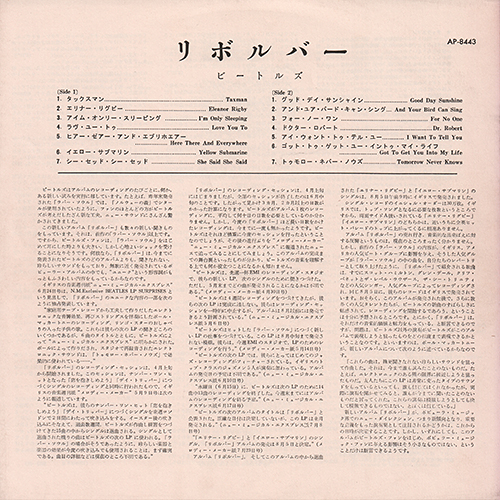 |
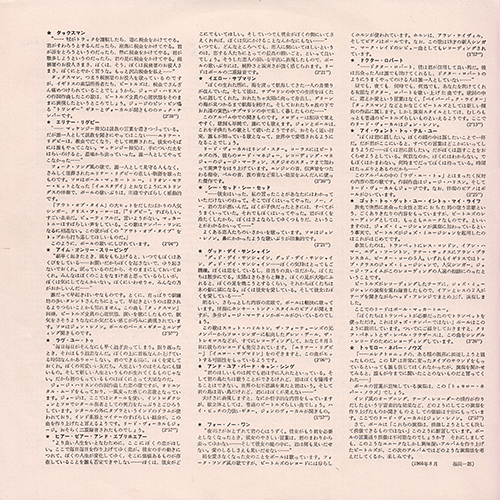 |
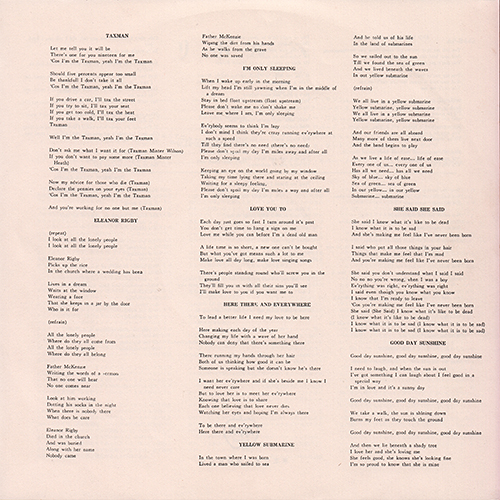 |
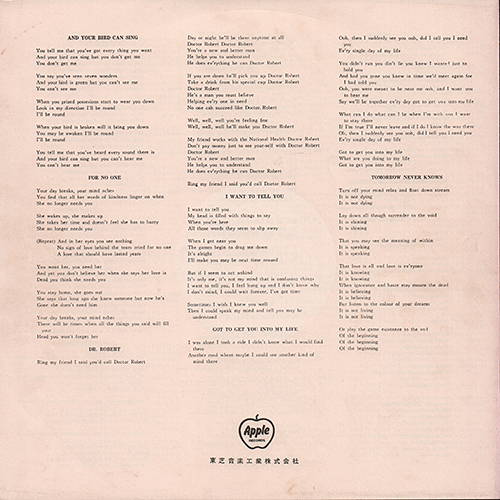 |
|
| LYRIC SHEET CLOSE UP | |||||
 |
 |
 |
Catalog
number,
Apple logo, and the company name were printed on the lyric
sheet. Liner notes: August 1966, Ichiro Fukuda. |
||
| Apple Green Arrow OBI CLOSE UP | |||||
| FRONT | BACK --> Click! | ||||
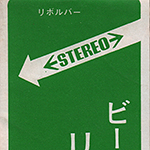 |
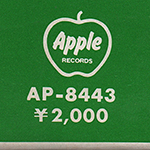 |
2nd. pressing had a green "arrow" OBI and
priced ¥2,000 on obi strip. The word "STEREO", Apple logo
mark and catalog
number "AP-8443" were printed on the front. |
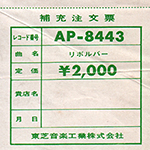 |
The obi remains intact
with the order form on the back uncut. |
|
| FRONT AND BACK COVER CLOSE UP | |||||
| FRONT COVER | BACK COVER | Caqtalog
number
and Apple logomark were printed on both sides of the sleeve. "Ever Clean" logo mark was removed on the back cover. |
|||
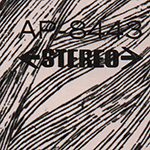 |
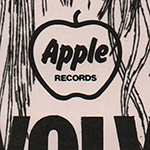 |
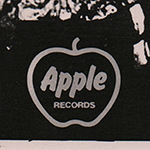 |
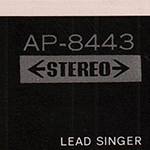 |
||
| BACK COVER CLOSE UP | |||||
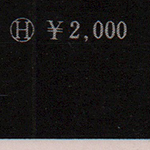 |
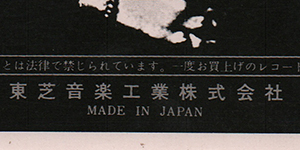 |
 |
"H ¥2,000" and the company
name "Toshiba Musical Industries Ltd." were printed at the
bottom of the back cover. The words "PAT." was removed at the lower right of the cover. |
||
| LABEL CLOSE UP | |||||
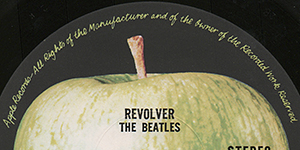 |
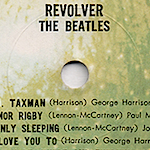
|
In 1969,
Toshiba had to reissue on the Apple label all the records
previously issued on the Odeon label. The phrase "Apple Records - All Rights of the Manufacturer and of the Owner of the Recorded work Reserved." was printed at the perimeter. |
|||
| LABEL CLOSE UP | |||||
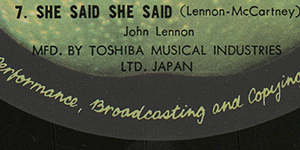 |
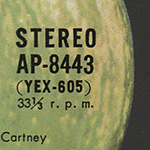 |
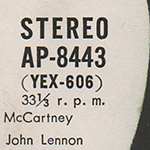
|
The words "MFD. BY TOSHIBA
MUSICAL INDUSTRIES LTD. JAPAN" was printed at the bottom of
the label. Catalog number "AP-8443" and matrix number were printed at the right side of the center hole. |
||
|
OTHER ITEM
|
|||||
| - | |||||
| RECORD LABEL | Light Green Apple label Type-2-1 |
||||
| MIX | STEREO | ||||
| MATRIX No. | SIDE 1 | YEX-605-3 16 | |||
| SIDE 2 | YEX-606-3 40 | ||||
| PRESS MARK | 2B
-> 2K |
||||
| VINYL COLOR | RED |
||||
| RECORD COMPANY'S NAME | SLEEVE | Toshiba
Ongaku kogyo Kabusikigaisha |
|||
| LABEL | MFD. BY
TOSHIBA MUSICAL INDUSTRIES LTD. JAPAN |
||||
| SYMBOL/PRICE | H - ¥2,000 |
||||
| LYRIC SHEET STYLE | Bifold Type |
||||
| COVER FORM | Single type. Hard cover. Twin-flipback cover (straight type) |
||||
| INNER SLEEVE |
Apple
custom black sleeve |
||||
| OBI |
Green / white so called "Apple Arrow" OBI |
||||
| COVER DESIGN/ PHOTO/ NOTES | Notes: Ichiro Fukuda |
||||
|
COMMENTS
|
Light green Apple
label Type-2-1with black print. In late (September?)1969, Toshiba had to reissue on the Apple label all the records previously issued on the Odeon label. And in the Apple label, there are two subtypes, TOSHIBA MUSIC and TOSHIBA EMI. Further more, the early copies of the APPLE-TOSHIBA MUSIC type have dark Apple on its label, though the late copies have light one. Red vinyl: Besides good sound and quality printing, Japanese records also offered some other things of interest to the collector. One of the primary manufacturing companies in Japan, Toshiba, pressed a lot of their records on red, “Everclean” vinyl from 1958 through 1974 (maybe). While not pressed as collectors’ items, these red vinyl pressings are more sought out by collectors than their black vinyl counterparts. The Everclean vinyl was designed to be less prone to collecting static electricity and dust than the more common black vinyl. The obi: A. K. A."Arrow" Obi 3rd. pressing had a green / white so called "Arrow" OBI and priced ¥2000 on rear sleeve and obi strip. On June 1967, starting with "Oldies (OP-8016)", numbering for new Odeon LPs changed to the 8000 range numbers. So Obis were renew, A.K.A. Odeon "Arrow Obi" in green and with the same design as the Apple Obis. While most Japanese records feature local music, a lot of music fans there like foreign music, as well. The language barrier in Japan presented a problem – should foreign album covers be changed for Japanese albums? The solution was the obi, which means “belt” or “sash”. The obi is a strip of paper, usually about two inches wide, that wraps vertically around the album cover, containing information about the artist and album in Japanese. As these strips of paper were fragile and easily torn, they are often missing, especially since consumers in the 1950s and 1960s attached little significance to them. Finding Japanese records made prior to 1970 that still have the obi intact can be quite difficult, and for some albums, nearly impossible. The inclusion of the obi can dramatically affect the price of some Japanese records, sometimes increasing the price by a factor of ten. |
||||
